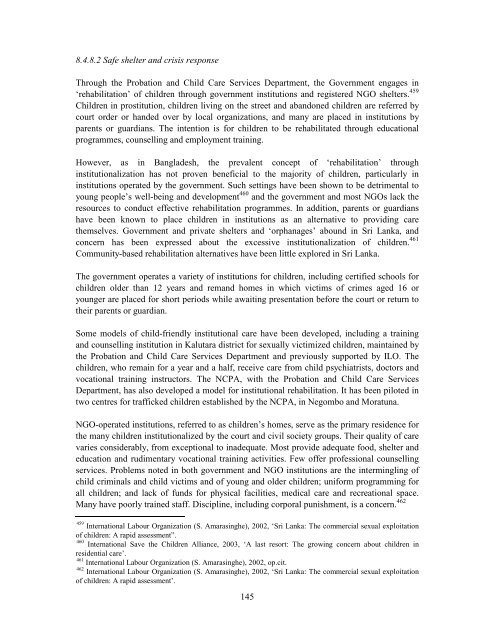SEXUAL ABUSE AND EXPLOITATION OF BOYS IN SOUTH ASIA A ...
SEXUAL ABUSE AND EXPLOITATION OF BOYS IN SOUTH ASIA A ...
SEXUAL ABUSE AND EXPLOITATION OF BOYS IN SOUTH ASIA A ...
You also want an ePaper? Increase the reach of your titles
YUMPU automatically turns print PDFs into web optimized ePapers that Google loves.
8.4.8.2 Safe shelter and crisis response<br />
Through the Probation and Child Care Services Department, the Government engages in<br />
‘rehabilitation’ of children through government institutions and registered NGO shelters. 459<br />
Children in prostitution, children living on the street and abandoned children are referred by<br />
court order or handed over by local organizations, and many are placed in institutions by<br />
parents or guardians. The intention is for children to be rehabilitated through educational<br />
programmes, counselling and employment training.<br />
However, as in Bangladesh, the prevalent concept of ‘rehabilitation’ through<br />
institutionalization has not proven beneficial to the majority of children, particularly in<br />
institutions operated by the government. Such settings have been shown to be detrimental to<br />
young people’s well-being and development 460 and the government and most NGOs lack the<br />
resources to conduct effective rehabilitation programmes. In addition, parents or guardians<br />
have been known to place children in institutions as an alternative to providing care<br />
themselves. Government and private shelters and ‘orphanages’ abound in Sri Lanka, and<br />
concern has been expressed about the excessive institutionalization of children. 461<br />
Community-based rehabilitation alternatives have been little explored in Sri Lanka.<br />
The government operates a variety of institutions for children, including certified schools for<br />
children older than 12 years and remand homes in which victims of crimes aged 16 or<br />
younger are placed for short periods while awaiting presentation before the court or return to<br />
their parents or guardian.<br />
Some models of child-friendly institutional care have been developed, including a training<br />
and counselling institution in Kalutara district for sexually victimized children, maintained by<br />
the Probation and Child Care Services Department and previously supported by ILO. The<br />
children, who remain for a year and a half, receive care from child psychiatrists, doctors and<br />
vocational training instructors. The NCPA, with the Probation and Child Care Services<br />
Department, has also developed a model for institutional rehabilitation. It has been piloted in<br />
two centres for trafficked children established by the NCPA, in Negombo and Moratuna.<br />
NGO-operated institutions, referred to as children’s homes, serve as the primary residence for<br />
the many children institutionalized by the court and civil society groups. Their quality of care<br />
varies considerably, from exceptional to inadequate. Most provide adequate food, shelter and<br />
education and rudimentary vocational training activities. Few offer professional counselling<br />
services. Problems noted in both government and NGO institutions are the intermingling of<br />
child criminals and child victims and of young and older children; uniform programming for<br />
all children; and lack of funds for physical facilities, medical care and recreational space.<br />
Many have poorly trained staff. Discipline, including corporal punishment, is a concern. 462<br />
459<br />
International Labour Organization (S. Amarasinghe), 2002, ‘Sri Lanka: The commercial sexual exploitation<br />
of children: A rapid assessment”.<br />
460<br />
International Save the Children Alliance, 2003, ‘A last resort: The growing concern about children in<br />
residential care’.<br />
461<br />
International Labour Organization (S. Amarasinghe), 2002, op.cit.<br />
462<br />
International Labour Organization (S. Amarasinghe), 2002, ‘Sri Lanka: The commercial sexual exploitation<br />
of children: A rapid assessment’.<br />
145










